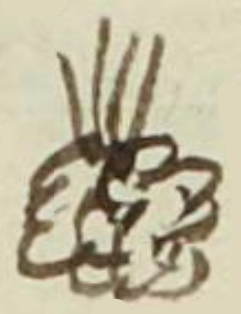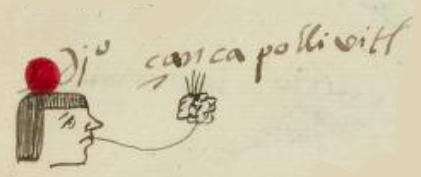Zacapolihuitl (MH783v)
This black-line drawing of the compound glyph for the personal name Zacapolihuitl (perhaps “Weed Destruction”) is attested here as a man’s name. The glyph shows four blades of grass, hay, straw, or weeds (zacatl). Weeding was important for clearing fields before planting. Below the weeds or straw is a shape that resembles a cloud of dust (teuhtli).
Stephanie Wood
Perhaps the cloud of dust suggests how the destruction or disappearance of weeds might appear. It is also reminiscent of the place name Cocollan, which refers to anger.
Stephanie Wood
dio çancapollivitl
Diego Zacapolihuitl
Stephanie Wood
1560
Jeff Haskett-Wood
malezas, pasto, heno, paja, destrucción, quitar, nombres de hombres

zaca(tl), weeds, grasses, hay, straw, https://nahuatl.wired-humanities.org/content/zacatl
polihui, to disappear or be destroyed, https://nahuatl.wired-humanities.org/content/polihui
Destrucción de Zacate
Stephanie Wood
Matrícula de Huexotzinco, folio 783v, World Digital Library, https://www.loc.gov/resource/gdcwdl.wdl_15282/?sp=641&st=image.
This manuscript is hosted by the Library of Congress and the World Digital Library; used here with the Creative Commons, “Attribution-NonCommercial-ShareAlike 3.0 License” (CC-BY-NC-SAq 3.0).



